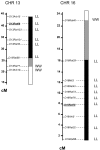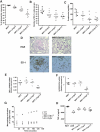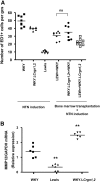Genetic loci modulate macrophage activity and glomerular damage in experimental glomerulonephritis
- PMID: 20488952
- PMCID: PMC3152224
- DOI: 10.1681/ASN.2009090968
Genetic loci modulate macrophage activity and glomerular damage in experimental glomerulonephritis
Abstract
The Wistar Kyoto (WKY) rat is uniquely susceptible to experimentally induced crescentic glomerulonephritis. Two major quantitative trait loci (QTLs) on chromosomes 13 (Crgn1) and 16 (Crgn2) with logarithm of odds >8, as well as five other loci (Crgn3 through 7), largely explain this genetic susceptibility. To understand further the effects of Crgn1 and Crgn2, we generated a double-congenic strain by introgressing these loci from glomerulonephritis-resistant Lewis rats onto the WKY genetic background. Induction of nephrotoxic nephritis in the double-congenic rats (WKY.LCrgn1,2) produced markedly fewer glomerular crescents, reduced macrophage infiltration, and decreased expression of glomerular TNF-alpha and inducible nitric oxide synthase expression compared with control animals. Bone marrow and kidney transplantation studies between parental and WKY.LCrgn1,2 strains, together with in vitro experiments, demonstrated that Crgn1 and Crgn2 contribute exclusively to circulating cell-related glomerular injury by regulating macrophage infiltration and activation. The residual genetic susceptibility to crescentic glomerulonephritis in WKY.LCrgn1,2 rats associated with macrophage activity (especially with enhanced metalloelastase expression) rather than macrophage infiltration. Taken together, these results demonstrate that a genetic influence on macrophage activation, rather than number, determines glomerular damage in immune-mediated glomerulonephritis.
Figures





Similar articles
-
Experimental crescentic glomerulonephritis: a new bicongenic rat model.Dis Model Mech. 2013 Nov;6(6):1477-86. doi: 10.1242/dmm.012328. Epub 2013 Aug 15. Dis Model Mech. 2013. PMID: 24046355 Free PMC article.
-
Genetic susceptibility to experimental autoimmune glomerulonephritis in the Wistar Kyoto rat.Am J Pathol. 2012 May;180(5):1843-51. doi: 10.1016/j.ajpath.2012.01.029. Epub 2012 Mar 22. Am J Pathol. 2012. PMID: 22445570 Free PMC article.
-
Genes expressed by both mesangial cells and bone marrow-derived cells underlie genetic susceptibility to crescentic glomerulonephritis in the rat.J Am Soc Nephrol. 2007 Jun;18(6):1816-23. doi: 10.1681/ASN.2006070733. Epub 2007 May 2. J Am Soc Nephrol. 2007. PMID: 17475818
-
Jund is a determinant of macrophage activation and is associated with glomerulonephritis susceptibility.Nat Genet. 2008 May;40(5):553-9. doi: 10.1038/ng.137. Nat Genet. 2008. PMID: 18443593 Free PMC article.
-
Identification of Ceruloplasmin as a Gene that Affects Susceptibility to Glomerulonephritis Through Macrophage Function.Genetics. 2017 Jun;206(2):1139-1151. doi: 10.1534/genetics.116.197376. Epub 2017 Apr 26. Genetics. 2017. PMID: 28450461 Free PMC article.
Cited by
-
Characterization of the macrophage transcriptome in glomerulonephritis-susceptible and -resistant rat strains.Genes Immun. 2011 Mar;12(2):78-89. doi: 10.1038/gene.2010.61. Epub 2010 Dec 23. Genes Immun. 2011. PMID: 21179115 Free PMC article.
-
AP-1 transcription factor JunD confers protection from accelerated nephrotoxic nephritis and control podocyte-specific Vegfa expression.Am J Pathol. 2011 Jul;179(1):134-40. doi: 10.1016/j.ajpath.2011.03.006. Epub 2011 May 3. Am J Pathol. 2011. PMID: 21640331 Free PMC article.
-
Experimental crescentic glomerulonephritis: a new bicongenic rat model.Dis Model Mech. 2013 Nov;6(6):1477-86. doi: 10.1242/dmm.012328. Epub 2013 Aug 15. Dis Model Mech. 2013. PMID: 24046355 Free PMC article.
-
Role of novel rat-specific Fc receptor in macrophage activation associated with crescentic glomerulonephritis.J Biol Chem. 2012 Feb 17;287(8):5710-9. doi: 10.1074/jbc.M111.260695. Epub 2011 Dec 19. J Biol Chem. 2012. PMID: 22184119 Free PMC article.
-
Combined ChIP-Seq and transcriptome analysis identifies AP-1/JunD as a primary regulator of oxidative stress and IL-1β synthesis in macrophages.BMC Genomics. 2013 Feb 11;14:92. doi: 10.1186/1471-2164-14-92. BMC Genomics. 2013. PMID: 23398888 Free PMC article.
References
-
- Jennette JC, Heptinstall RH, Ovid Technologies Inc. : Heptinstall's Pathology of the Kidney, 6th Ed., Philadelphia, Lippincott Williams & Wilkins, 2007
-
- Tipping PG: Crescentic nephritis: Is it in your genes? Nephrol Dial Transplant 23: 3065–3066, 2008 - PubMed
-
- Tam FW, Smith J, Morel D, Karkar AM, Thompson EM, Cook HT, Pusey CD: Development of scarring and renal failure in a rat model of crescentic glomerulonephritis. Nephrol Dial Transplant 14: 1658–1666, 1999 - PubMed
-
- Smith J, Lai PC, Behmoaras J, Roufosse C, Bhangal G, McDaid JP, Aitman T, Tam FW, Pusey CD, Cook HT: Genes expressed by both mesangial cells and bone marrow-derived cells underlie genetic susceptibility to crescentic glomerulonephritis in the rat. J Am Soc Nephrol 18: 1816–1823, 2007 - PubMed
-
- Aitman TJ, Dong R, Vyse TJ, Norsworthy PJ, Johnson MD, Smith J, Mangion J, Roberton-Lowe C, Marshall AJ, Petretto E, Hodges MD, Bhangal G, Patel SG, Sheehan-Rooney K, Duda M, Cook PR, Evans DJ, Domin J, Flint J, Boyle JJ, Pusey CD, Cook HT: Copy number polymorphism in Fcgr3 predisposes to glomerulonephritis in rats and humans. Nature 439: 851–855, 2006 - PubMed

